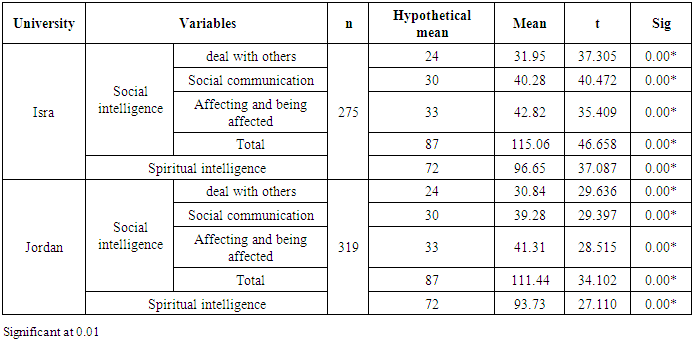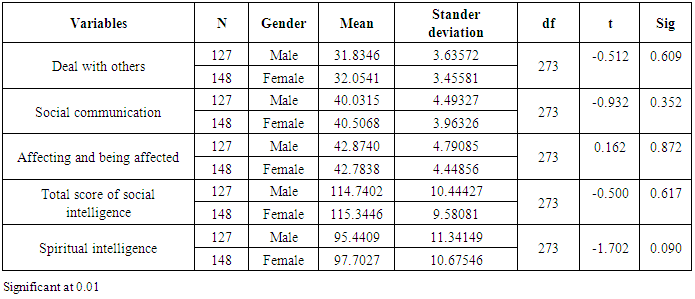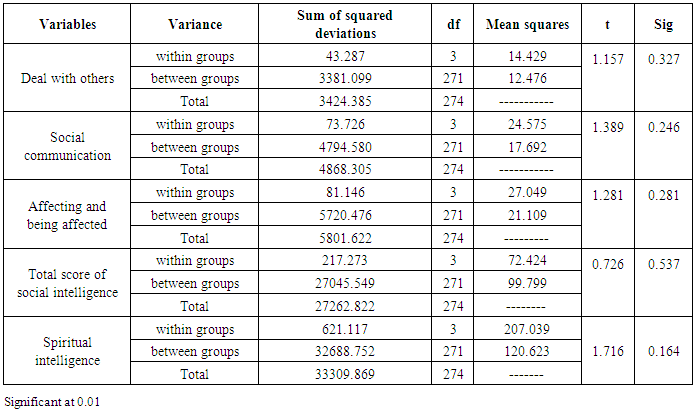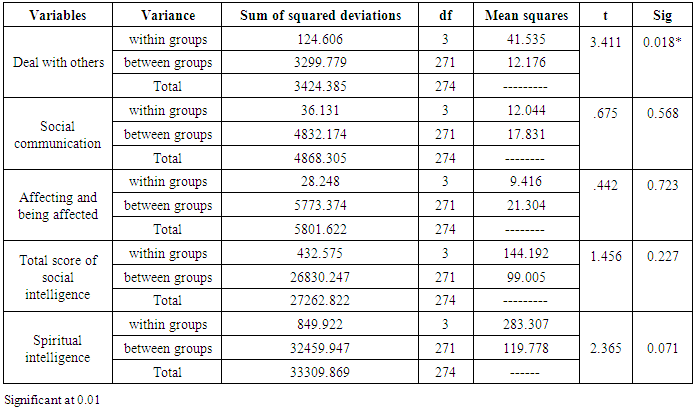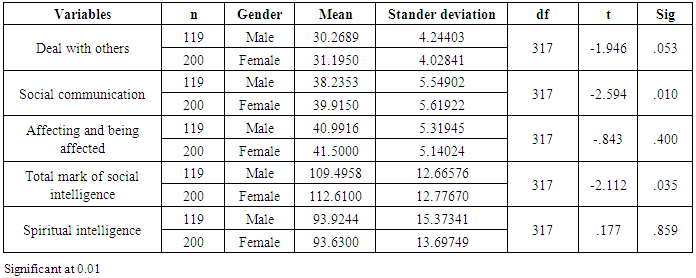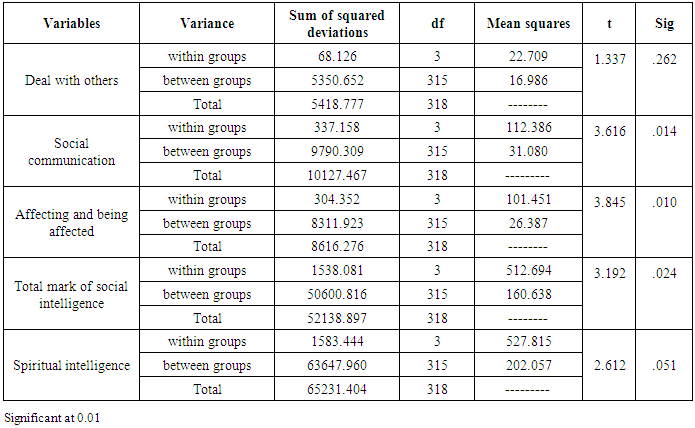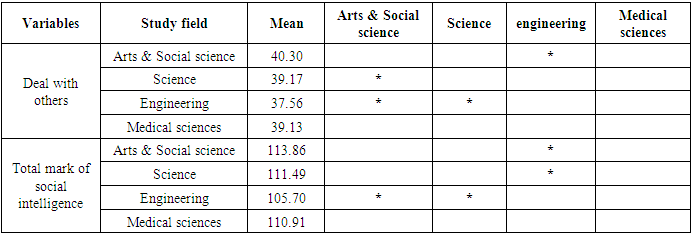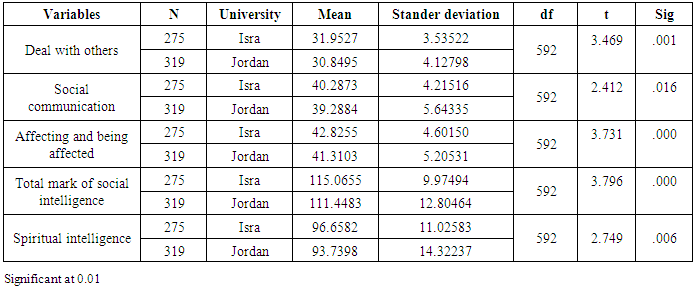-
Paper Information
- Previous Paper
- Paper Submission
-
Journal Information
- About This Journal
- Editorial Board
- Current Issue
- Archive
- Author Guidelines
- Contact Us
International Journal of Psychology and Behavioral Sciences
p-ISSN: 2163-1948 e-ISSN: 2163-1956
2018; 8(5): 81-95
doi:10.5923/j.ijpbs.20180805.02

Spiritual and Social Intelligence among University Students in the Light of Some Variables: A Comparative Study
Hani S Alkhaldi, Malek Y. Alkhutaba
Psychology Department, Isra University, Amman, Jordan
Correspondence to: Malek Y. Alkhutaba, Psychology Department, Isra University, Amman, Jordan.
| Email: |  |
Copyright © 2018 The Author(s). Published by Scientific & Academic Publishing.
This work is licensed under the Creative Commons Attribution International License (CC BY).
http://creativecommons.org/licenses/by/4.0/

This study aims to explore the spiritual and social intelligence among Isra and Jordan university students. The sample of the study consists of 594 participants (Isra University 275 & Jordan University 319). The sample of the study was chosen randomly in second semester of the academic year 2017 – 2018. The researchers adopted two scales. The spiritual intelligence scale was adopted from Atbi, 2017 and social intelligence scale adopted from Abu Amsha, 2013. The findings of the study indicated that that there were statistically significant differences between Isra and Jordan university students in social intelligence and spiritual one in favor of Isra university students. In addition, the findings concluded that the total percentage of social intelligence is 33.1% for Isra students and 33.7% for Jordan university students in spiritual intelligence. Furthermore, there were no statistically significance differences in social and spiritual intelligences regard sex and level of the study. Finally, the study showed that there were statistically significance differences in the dimension of affecting and being affected of social intelligence and spiritual intelligence in favor of Arts and Humanities specializations.
Keywords: Spiritual intelligence, Social intelligence, Isra and Jordan university, University student
Cite this paper: Hani S Alkhaldi, Malek Y. Alkhutaba, Spiritual and Social Intelligence among University Students in the Light of Some Variables: A Comparative Study, International Journal of Psychology and Behavioral Sciences, Vol. 8 No. 5, 2018, pp. 81-95. doi: 10.5923/j.ijpbs.20180805.02.
Article Outline
1. Introduction
- Intelligence definition can be better understood through categories, categories such as logic capacity, understanding, self-awareness, learning, emotional knowledge, reasoning, planning, creativity, and problem solving which provides a comprehensible understanding of intelligence. Generally, intelligence means the capability to understand information and to maintain it as knowledge that can be applied towards other adaptive behaviors within an environment or certain situations. Although intelligence has been widely studied on humans, it has also been monitored on both non-humans, animals and plants. Furthermore, intelligence can be exhibited and measured by “artificial intelligence”, which is a common computer software implemented in computer system. intelligence is a gift but not a memory; a person can be oblivious and yet considered intelligent. additionally, intelligence is neither a skill a worker can acquire after planned practice nor an award of a good behavior of the individual.According to Gardens, 2000 there are five types of intelligence to which he added a spiritual one represented in the individual’s ability to comprehend spiritual relations. The others are: corporal intelligence by which the individual is able to distinctively and skillfully use his body in dancing and in sports [1], intelligence of music which is essential for the perfection of various types of music, personal intelligence which reflects the individual’s consciousness of his ideas and emotions, social intelligence which enables the individual to understand others, establish social relations with them, and sympathize with their feelings and wishes [2].The spiritual intelligence was highly considered by psychologist for being one of the several types of intelligence. They attempted to disclose its characteristics and correlate it to brain researches and psychological health in order to figure out its impact upon personality and long-term behavioral benefits, in addition to spiritual and emotional sensitivities [3]. The spiritual intelligence correlates to internal mental, spiritual, and existential life in this world. This intelligence involves deep understanding of existing objects, spiritual awareness of the existence of plants, animals, humans, metal and materialistic life, and objects such as body, mind and soul. Thus, the spiritual intelligence is more than just a mental ability but extends to what is beyond the traditional psychological development and the individual’s self-awareness. It implies the awareness of our relationships for being above these relations and of whatever exists on this earth [4].The spiritual intelligence opens the heart, inspires the soul, and relates it to its surrounding. Through practice this intelligence may develop and help the individual to distinguish between reality and illusion, correlating it to the way through which the individual acquires and develops qualities. It also correlates to personal and social intelligences. The personal intelligence is typified through the individual’s self-understanding and development, while the social counterpart is represented through self-understanding and respecting others which will eventually end up with understanding all modes of life [4].It may also be typified in the individual’s ability to rid of life situations and to convince those who are around, to harmonize with them and plan to achieve his goals. Social intelligence might be regarded one of the means which might be used positively or negatively. It signifies the individual’s ability to understand others and to behave wisely in social circumstances. It is an aspect of awareness. The social conformity involves a knowledge about the others with regard to their opinions, consciousness, feelings, and personal intentions. This ability plays a significant role with those who directly deal with others [5].
2. Problem of the Study
- Human nature is an integrated unit whose dimensions are in conformity with one another. The foremost among them are the inseparable social and spiritual dimensions. Any individual usually responds to the social domain in accordance with his overall personal qualities. Both intelligences, the spiritual and social qualities, in addition to freedom and responsibility, are what distinguish the human from animals. The spiritual dimension is distinguished for self-sublimation, faith, intuition, prudence, inspiration, conscience, and an aim in this life. It is also the dimension by which the individual is singled out with human qualities such as love and conscience. Man is social by nature; he loves to live with others in peace. In an attempt to achieve his goals, he is forced to deal with others irrespective of their intentions, personalities and motives [6].The individual has to enjoy a certain degree of social intelligence to help him confront life with its thrills and spills and to deal with others in a way through which he achieves his goals. The social intelligence strongly correlates to the individual’s personality and behavior. Individuals, distinguished for social intelligence, possess self-awareness and the ability to understand their environment through understanding others and through responding wisely to those of various motives.They also have the ability to establish social relations, develop friendships and determine wishes of others. The problem of the study also shows that spiritual intelligence is a modern topic which appeared in an article published by Emmon in 2000. In that article Emmon he stated that spiritualism is a mode of intelligence which he called spiritual intelligence [7]. Thus, the problem of the study is to unravel the level of social and spiritual intelligences and to compare them between students of Jordan University and those of Isra.
3. Significance of the Study
- The importance of this study lies in focusing on the spiritual intelligence which maintains equilibrium for the social counterpart, one aspect of human personality changes as a result of psychological stress, personal interests and increasing egoism in which variables and values drastically change. If the individual possesses some of the positive values, a strong and clear behavior, then he will be able to easily deal with crises and difficult life problems. As the group of interest in this study is the one which should have social and spiritual intelligences to be more aware of their status and position in this life, then the study will contribute to determining the level of social and spiritual intelligences among university students. This level of intelligence is strongly correlated to the success of the student in his social life in particular and to any individual in general. It also increases the cognitive part of the university student’s knowledge.
4. Objective of the Study
- This study seeks to:1. examine the level of the social intelligence and the spiritual one of the students from the universities-Isra and Jordan?2. explore whether social intelligence a predictor of spiritual intelligence in Isra and Jordan university students.3. know the impact of gender, level of the study, and study field on social and spiritual intelligence at Isra and Jordan university students.4. find out the difference in social and spiritual intelligence between Isra and Jordan university students.
5. Questions of the Study
- 1. what is the level of the social intelligence and the spiritual one of the students from the universities-Isra and Jordan?2. to what extent does social intelligence contribute to the prediction of spiritual intelligence for students of Isra and Jordan Universities?3. are there differences with statistical significance in both the spiritual and social intelligences for Isra and Jordan universities students which might be attributed to the variables of (gender, study level and study field).4. do Isra and Jordan university students differ in social and spiritual intelligence?
6. Study Terminology
- First, social intelligence: Procedure wise, in this study: it is defined as the degree the respondent achieves at the social intelligence scale, as exemplified in: affecting and being affected, deal with others, and social communication. Second, spiritual intelligence:Procedure wise in this study: it is defined as the degree the respondent achieves at the spiritual intelligence scale.
7. Limitations of the Study
- Findings of this study can’t be generalized as they are only limited to, the students at both Isra and Jordan university in second semester of the academic year 2017 – 2018, and to the present study scales, i. e., social intelligence as well as the spiritual one.
8. Literature Review
- Obeidi (2014) examined the spiritual intelligence among Baghdad University students in the light of sex, level of study and educational stream variables, the sample of the study include 300 university students, and the tools of the study were prepared by the researcher. Results of the study revealed that high level of spiritual intelligence between the university students, also there are no statistically differences in the level of spiritual intelligence base on sex and educational stream variables. Moreover, results of the study showed statistically differences in the level of spiritual intelligence between first year students and fourth year ones in favor of fourth year students [6].Shahrani (2015) investigated the spiritual intelligence and its relationship to mental health among King Khaled University students, it also aimed to find out the differences in spiritual intelligence between student's base on academic specialization and level of study variables. The study sample consisted of 430 students while the relationship of spiritual intelligence and mental health were measured by the spiritual intelligence scale, developed by Fathi, 2012 and mental health scale of Zubaidi and Hazza, 1997. The study results showed that the level of Spiritual Intelligence was high among king Khaled university students, with significant differences in the level of spiritual intelligence between students of second level and students of seventh level in favor of second level students. The results of the study indicated no significant differences in the level of spiritual intelligence between students with respect to academic specializations of students [8]. Also, Abdul Wahab and Abdullah (2016) studied the social intelligence among Riyadh children in the light of some variables, the sample of the study compromised 200 children (103 boys & 97 girls) from Kindergartens and preliminary children. Results of the study indicated no statistically difference in social intelligence between Kindergarten and preliminary children [9]. Abdelnaser and Wael (2016) detected the social intelligence and conflict management strategies among high intact and problematic behavior students. A total sample of 439 students, which was randomly clustered selected, was selected from Al-Galilee district in Palestine, the secondary stage students of the scholastic year 2013/2014. The social intelligence and Toomey conflict management strategies scales were used. Results of the study indicated that subjects have a high level of social intelligence while, the strategy of integrating was the most effective strategy among them. There were no gender significant differences between students in social intelligence, and significant difference in social intelligence level between students in favor of intact subject. Finally, there were gender significant differences between in emotional expression, neglect, and integrating strategies [10]. Moreover, Atbi (2017) explored the level of spiritual intelligence among high and low achiever university achievers. The sample of the study consisted of 360 male and female students selected from Basrah university. Results of the study indicated that the level of spiritual intelligence was high among high achievers and low among low ones, with statistically significant differences with respect to gender variables in favor of male students. The results also showed no statistically differences in the level of spiritual intelligence with respect to academic stream variable [11].
9. The Concept of Spiritual Intelligence
- Gardns, 2000 defined it as the intelligence by which we solve our problems, develop our values and actions in this life, and at the best to peacefully live with ourselves and with others [1]. Nasel, 2004 indicated that the spiritual intelligence is that which reflects individual’s capability and spiritual potentials which make him more confident about the meaning of life. It also enables him to face life existential, and spiritual problems and find solutions for them [12]. As for Vaughan, 2016 he stated that spiritual intelligence is the ability to deeply understand problems with an insight for the various problems of consciousness [4].
10. Components of Spiritual Intelligence
- King, 2008 specified them into four as follows:1. Existential thinking: it is represented in producing and creating the meaning which is based on deep understanding and feeling for problem solving.2. Production of self or personal meaning: this is represented in merging individual’s materialistic and mental experiences with the personal one which leads to contentment.3. Sublimated consciousness: this is reflected in the individual’s understanding of his relations with other living organisms and his acknowledgement of natural reality.4. Broadening state of consciousness: this is reflected in the ability of concentration, analytical thinking, tolerance, patience, and acceptance of unfamiliar and contradictory experiences [13].
11. Characteristics of Spiritual Intelligence
- There are several behavioral characteristics enjoyed by those of high capabilities of spiritual intelligence reflected in:1. A distinctive capability of correlating different things.2. Self-consciousness of whatever the individual feels, internally or externally.3. Flexibility and ability to adapt oneself to circumstances through which the individual goes besides merging and understanding all situations.4. A high level of capability to confront frustration and failure benefiting from past experiences, ambition, and ability to work in the future [14].
12. The Concept of Social Intelligence
- Edward Thorndike, 1920 defined it as the ability to understand and deal with men, women, boys and girls in addition to a prudent dealing with human relations [15]. Wong. et.al, 1995 pointed out that the concept of social intelligence consists of two sides:a. Cognitive side: this refers to the individual’s ability to comprehend and decipher verbal and non-verbal behavior of others. This is exemplified in consciousness, insight, and social awareness.b. Behavioral side: this refers to the range of influence and interaction with others the individual possesses [16].Ross Honeywill, 2015 sees that the social intelligence is the total outcome of psychological and social awareness, in addition to social beliefs, developing stances, control capabilities, and the will to control complex social change [17].
13. Components of Social Intelligence
- Abu shaera & Ghabari, 2010 specified a group of factors constituting social intelligence in:1. Group organizing: the leadership skill necessitates to start coordinating common efforts of individuals. These capabilities are enjoyed by play producers, military, organization heads, and influential people.2. Negotiable Solutions: it is a talent of the mediator by which he can prevent disputes and find solutions for existing ones. Such mediators excel in concluding transactions, mediating disputes or legal arbitration.3. Personal relations: this talent is characterized by individual’s ability to face and understand people’s feelings and concerns in an appropriate manner.4. Social analysis: it is the ability to discover other feelings through deep insight to determine their interests and motives. Such an ability leads to the creation of intimate relations and conformity [14].
14. Dimensions of Social Intelligence
- Through an empirical study, Marlow specified five dimensions of social intelligence as follows:1. Social interest: this is concerned with individual’s inclination toward any human group.2. Social skills: these imply individual’s ability to use the skills of active social interaction with others.3. Empathy skills: these imply understanding and sympathizing with others.4. Social anxiety: it refers to the level of individual’s perplexity and experience in numerous social situations.5. Sentimentality: it refers to the individual’s ability to comprehend and predict the reaction of others with regard to dealing with them [18].
15. Hypotheses Illustrating Social and Spiritual Intelligences
- First, Implicit theory:Ford in his study about the nature of social intelligence, mentioned that this theory comprises four major qualities of the intelligent person:1. The person should feel with others, respect their rights and viewpoints. He should also be faithful and interested in them. In addition, he should be a reliable person distinguished for having a high level of social responsibility.2. The person should have good working skills i.e. knows how to accomplish duties, has highly competent skills for human communication, able to determine his goals, and has leadership capabilities.3. He should have social competence which involves social simplicity that includes many qualities among which:a. Individual should have been involved in social activities and was socially adaptable, open to people, and easy to deal with.b. He also should be psychologically influential i.e. has a positive self-understanding with a good insight into actual life [19].Second, Multi-intelligence theory:It was introduced by Gardner and includes what he called “intelligence of mutual relations among people “taking into consideration social intelligence” that includes several abilities, the foremost of which are:a. Probing human feelings, motives, psychological condition, and disposition of others.b. The ability to build up successful relations with others and to be an active member in a team.c. The ability to sympathize with others [20].Third, Wolman’s Model:He viewed spiritual intelligence to consist of seven subsidiary factors among which are: feeling having a prime source of energy, vigilance, shock endurance, and spiritual childhood [21].Fourth, Amram and Dryer’s Model:In their model, they concluded that there are seven dimensions common to all individuals irrespective of their religion. These are: consciousness which includes “intuition, vigilance, and reconciliation”; benefaction includes: beauty, prudence, freedom, gratefulness, commitment, and joy; meaning includes: purpose and service, sublimation; includes: self-esteem, perfection practice and spiritual correlation; truth includes: self-denial, solemnity, internal integration, broad mindedness, agility, and trust [22].
16. Study Methodology and Procedures
16.1. Methodology
- The descriptive analytical method was adopted as it fits the study and its objectives.Corpus of the study: the corpus comprised 8000 male and female students 3000 from Isra University and 5000 from Jordan University. These students were selected from the faculties of Education, Science, Arts and Medical Sciences the second semester 2017 / 2018.
16.2. Sample of the Study
- The stratified sample of the study which was randomly chosen from the aforementioned four colleges as presented in table (1). comprised 594 male and female students. 275 from Isra and 319 from Jordan University.
|
16.3. Instruments of the Study
- First: Social intelligence scaleAfter studying literatures and past studies concerned with social intelligence, the study adopted Abu Amsha’s, 2013 social intelligence scale [23].Scale description: Abu Amsha divided the scale into three dimensions [23]:1. The ability to deal with others discussed in paragraphs: 1, 3, 4, 5, 6, 7, 8 and 12.2. Social communication discussed in paragraphs: 9, 10, 11, 12, 13, 14, 15, 16, 17 and 18.3. Affecting and being affected by social situations discussed in paragraphs: 19, 20, 21, 22, 23, 24, 25, 26, 27, 28, 29.Keys of Correction:Abu Amsha adopted the following key of correction: Negative statements were as follows: 4, 6, 7, 11, 17, 26 and 29.
|
|
|
|
|
|
|
|
17. Study Results Explication
17.1. Results of the First Question: What is the Level of the Social Intelligence and the Spiritual One of the Students from the Universities-Isra and Jordan?
- In answering the question, t-test was used for one sample in which the real means of the sample members was compared to hypothetical one in every dimension of those of social intelligence scale, with its total grade, to that of the spiritual one as follows:
|
17.2. Results of the Second Question: To what Extent does Social Intelligence Contribute to the Prediction of Spiritual Intelligence for Students of Isra and Jordan Universities?
- In answering this question, the two researchers analyzed the multiple regression using the Enter method for every sample of the two universities as illustrated in the two following tables.Table (11) presents on the analysis of multiple regression for predicting spiritual intelligence through the social one, shows that there is a statistical significance at the level (0.01) for the regression coefficient of: Social communication, affecting and being affected, and the mark of social intelligence. But there was no statistical significance for dealing with others. Beta value (β) ranged between (0.257) – (0.542), and R² value was (0.33). This means that each of social communication, affecting and being affected, and the total mark of social intelligence accounts for (%33.1) of the difference in spiritual intelligence. Thus, the prediction formula of social intelligence can be written this way: 30.909+0.257 x social communication + 0.347 x affecting and being affected + 0.542 x total mark of social intelligence.
|
|
17.3. Results of the Third Question: Are there Differences with Statistical Significance in Both the Spiritual and Social Intelligences for Isra and Jordan University Students which might be Attributed to the Variables of Gender, Study Level and Study Field
- To determine the differences t-test was applied to two independent samples to distinguish the differences attributed to sex and to analyze the unilateral difference to figure out the differences attributed to study field and study level as illustrated in the following tables:
|
|
|
|
|
|
|
|
|
17.4. Results of the Fifth Question: Do Isra and Jordan University Students Differ in Social and Spiritual Intelligence?
- To determine the differences t-test was applied to two independent samples to distinguish the differences attributed to Isra and Jordan university as described in the following table:
|
18. Discussion of Results
- Regarding results of the first question, these show that the level of social intelligence with its three dimensions (Social communication, affecting and being affected, and dealing with others) and spiritual intelligence were high for students of both universities. Students in general tend to communicate with each other as they need communication to solve assignments, to prepare for exams, and to participate in extra-curricular and sport activities. University students have moved from a developing stage to a new one, the university stage. Thus, the more the individual develops, the more the developmental qualities, especially those of social, safety and optimistic look to the future, grow in him. After university stage, he ushers into practical life. University students at this level pass through a late period of adolescence which means that they move from depending on others to self-dependence and social openness. Thus, they become more willing for social work, socially more mature, more active in social interaction and dealing with others. In university life, the student’s experience develops to a great extent through the various activities, the students he gets to know, and the openness toward the other sex. This will provide the student with a merit of how to deal with others.With regard to results of the second question, the two dimensions of social communication, affecting and being affected, and the mark of social intelligence help in predicting the spiritual intelligence. 33.1% of discrepancy of spiritual intelligence was gotten by Isra students, while 33.7% of that discrepancy was gotten by students of Jordan University. This stresses the significance of these variables to the university student. At this age stage, due to experiences they acquired, the new life to which they moved, and the various activities they acquired, will all be positively reflected in their life. They become more socially mature and more influential as the male and female students now try to prove themselves, academically, educationally, and socially. The university provides them with chances of openness, cooperation, acquainting with others, and communication through several educational, recreational, and sport activities. This led to the development of these variables in students, thus contributing to the prediction of spiritual intelligence.Results of the third question: are there differences with statistical significance in the spiritual and social intelligences of Isra students, attributed to variables of (sex, study level, and study field)? a. The results didn’t show any differences with statistical significance in the variables: social communication, affecting and being affected, social communication, total mark of social intelligence and spiritual intelligence, attributed to sex, study level, or specialization. The differences have only been found in the dimension of dealing with others, due to specialization. Both male and female students almost have the same level of social or spiritual intelligence: being peers, socially mature, living in a conservative society which adheres to a lot of norms and traditions, and to the principles of Islam which nurture their social side making them more optimistic and hopeful in this life. As for the dimension of dealing with others among students majoring in Arts Humanities, engineering, and medical sciences, the results were in favor of art and humanities majors. Students, in general, have a high level of quality with regard to dealing with others as a result of many factors which universities helped in, especially openness to the other sex and the new environment to which they moved. The dimension of dealing with others was higher with majors of arts and humanities than that of engineering and medical sciences majors. Majoring in arts and the particular activities of this specialization illustrate this: the nature of activities done by students of this major such as: plays, educational and poetic seminars, and sport completions increased students’ contacts which eventually led to the rise in this level.b. Are there differences with statistical significance in the spiritual and social intelligences among Jordan university students attributed to the variables: (sex, study level, and field level)? As for sex, there were no differences in the dimensions of social intelligence, dealing with others, affecting and being affected, and spiritual intelligence. But there were differences with statistical significance in the total mark of social intelligence and social communication in favor of females. Contrary to females who in the Jordanian society naturally stay home after college, males spend most of their time outside the house at work or for any other reason. Therefore, the female student stays in touch with her friends through social media available in every house. Such a constant contact outside college reinforce in females' social intelligence and social communication more than it does with male students.As for study level, there were differences with statistical significance in social communication, affecting and being affected, the total mark of social intelligence among freshmen, juniors, and seniors in favor of freshmen who need old friends to know more about the university. The freshman is the one who asks and communicates with others, thus encouraged to create friendships and relations, as he has more contacts with students from different environments and cultures that affect him more than old students do. With regard to study field, there were differences with statistical significance: the dimensions of affecting and being affected and the total mark of spiritual intelligence between art and humanities majors on one hand and engineering and science on the other in favor of arts and humanities. This result was formerly illustrated: the nature of art specialization together with the curricular and extra-curricular activities practiced by students of this specialization made them more influential and created in the students of art a set of capabilities and readiness which help him solve his problems, achieve his daily goals, and positively deal with daily events.Discussion of fourth question results: Are there differences with statistical significance in the spiritual and social intelligences between students at Isra University and their counterparts in Jordan University? Differences were found in the variables of social intelligence with its dimensions (social communication, affecting and being affected, and dealing with others) and in the spiritual intelligence, in favor of Isra’s students. This result can be explained through the following reasons:1. Isra being adjacent to a tribal society whose bonds are still stronger than that of the urban one. Jordan University is located in the heart of Amman and its students are from the capital itself. Due to the tribal society to which Isra students belong, family ties are stronger and that provides them with more contacts. As stated previously, the nature of transportation at Isra University strengthens such ties and makes communication easier for students.2. The surrounding society of Isra is conservative and committed to lots of norms and traditions, missing from urban life, which have been positively reflected on Isra’s students.3. Life surrounding Isra university is different because: unlike city, it is not crowded, with no hubbub, no factory pollution, and no close high-rise buildings, but a very calm environment rich with beauties that were positively reflected on students who become more optimistic and lovers of life.The findings of this study are in agreement with study of Obeidi, 2014, Shar, 2015, and Abdelnaser & Wael, 2016.
19. Conclusions
- The aim of the present study is to compare the social intelligence and the spiritual one among Isra and Jordan university students. This study has provided evidence, that there are differences between Isra and Jordan university students in social intelligence and spiritual one in favor of Isra university students. It can be explained that the societies nature, including: values, principles, traditions and customs are negatively or positively affects individuals. Where the students who belong to tribal society committed to values, principles, traditions and customs have social intelligence and ability to deal with and affect others or being affected more than students who belong to civil environmental. This refers to the unity that produces or is based on unities of: goals, criterion, empathies, and interests, and refers to the relation in a society that fasten the individuals together as one.
 Abstract
Abstract Reference
Reference Full-Text PDF
Full-Text PDF Full-text HTML
Full-text HTML








